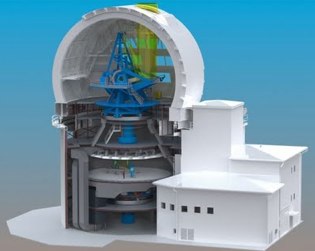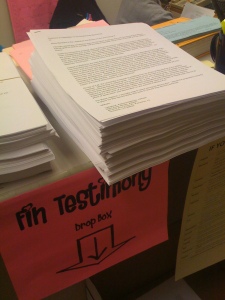Blog
News, updates, finds, stories, and tidbits from staff and community members at KAHEA. Got something to share? Email us at: kahea-alliance@hawaii.rr.com.
Collaborate Much?

We’re liking this thought-proving post from journalist Anne Minard, on the “next great telescope race”–Day 14 of her “100 Days of Science.” She asks some great questions about the fundamental purpose of the two U.S. proposals for “next generation” giant land-based telescopes being proposed for construction within the next 10 years. Do we really need THIS much telescope, guys?
Charles Alcock, director of the Harvard-Smithsonian Center for Astrophysics, acknowledged that the two telescopes are headed toward redundancy. The main differences, he said, are in the engineering.
He said the next generation of telescopes is crucial for forward progress in 21st Century astronomy.
“The goal is to start discovering and characterizing planets that might harbor life,” he said. “It’s very clear that we’re going to need the next generation of telescopes to do that.”
And far from being a competition, the real race is to contribute to science, said Charles Blue, a TMT spokesman.
“All next generation observatories would really like to be up and running as soon as possible to meet the scientific demand,” he said.
But when I asked him why the United States teams haven’t pooled their expertise to build a single next-generation telescope, Blue declined to comment.
In all, there are actually three teams (two from the U.S., and one from Europe) racing to build the first of these giant land-based telescopes: Extremely Large Telescope (Europe), TMT (U.S.), and Giant Magellan Telescope (U.S.). (And no, we’re not making these names up… in almost every description we could find, these bad boys are characterized first and foremost by their massive size.) The total estimated price tag for all this summit development? $2.6 billion dollars.
In the midst of this competition to build the first and the largest, the worldwide community of those who share aloha for sacred summits are humbly asking: for time and real consideration for native ecosystems, threatened endemic species, the cultural meaning of sacred space, cultural practice, and the natural and cultural heritage we have to pass forward to next generations… all in short supply on earth today. Can we not rationally slow down this latest race for space, in the interest of the future of life on our own planet?
Action Alert: Haleakala Solar Telescope

On August 26, the BLNR will hear public testimony on the 14-story telescope proposed for Haleakala. We really need community members to show up early, sign up to speak, and give testimony on this giant telescope proposal. You can read the flyer here.
From Kilakila Haleakala:
All studies done for the proposed project indicate that in addition to the misuse of conservation lands, there will be major, adverse, short- and long-term direct impacts on traditional and cultural resources. We must let them know know that our summit will not be furuther desecrated.
You can read more at http://www.kilakilahaleakala.org
Wanting another perspective? We’re also liking this thoughtful take on the Haleakala proposal by blogger and astronomer Salman Hameed.
Hawaiians, mountain in 'Avatar'-like struggle
From Marti:
Great editorial in the Sacramento Bee yesterday about the analogies between the struggle depicted in the movie Avatar and the real world struggle to protect the last pristine plateau of Mauna Kea. Here’s a quote:
The California astronomers’ “unobtanium” quest – research papers revealing “the secrets of the universe” and identifying planets beyond our solar system – is certainly more noble than mining minerals, but it’s another example of promoting one culture’s notion of progress by overriding another’s reverence for the land. As in the movie, behind the Mauna Kea invaders stands the big money of a starry-eyed entrepreneur, Intel co-founder and telescope donor Gordon Moore.
Particularly rich was the comment posted by Richard Ha about the importance of process. Totally agree, Uncle, which is why we oppose a plan to manage the summit conservation district that is written by the lead-developer of the summit. Just as one example, the plan puts no limit on the number of telescopes that could be built on the summit.
This is not surprising. For decades, the University of Hawaii has promised to better protect the natural and cultural resources of the summit while actively destroying them. This TMT+CMP combo is just the latest example.
10-to-1 opposed and they still passed it
From Marti:
The bill to transfer management of the sacred summit of Mauna Kea to the University of Hawaii passed the state’s House Finance Committee on Tuesday. By the Committee’s own count, 900 people submitted testimony in opposition to the 10 or so in support. This number is not counting the testimony submitted by a dozen Kanaka Maoli (Native Hawaiian) scholars who signed a joint letter in opposition to the bill, as well as testimony from the Hawaii Sierra Club, the Royal Order of Kamehameha I, and several individual Native Hawaiian cultural practitioners detailing the history of destruction and desecration from the University’s 40 years of telescope construction on the summit.
This bill is extremely dangerous for the future of our sacred summit and all of our conservation lands. It gives the University – the developer of the summit – control over what happens to the natural and cultural resources of the conservation district that currently protects the entire summit of the mountain, setting a terrible precedent for delegating the state’s conservation responsibilities to developers.
The bill would also allow the University to establish its own private police force on the summit. These “rangers” do not have the same level of training or authority as the state resource enforcement officers who currently have jurisdiction over the summit. In fact, these “rangers” themselves have engaged in desecration of cultural sites, interfered with spiritual and religious practice on the summit, and endangered unique, fragile natural resources.
In addition, the bill would allow the University to pocket state money with no oversight by establishing a special fund. For 40 years, the University has facilitated the theft of state money by foreign telescope owners who construct massive telescope facilities (and all of the gift shops, parking lots, and other support structures that go with them) on state land without paying rent to the state. In addition, millions in profits is made from the sale of patented information developed on the summit. Instead of offering to pay some of this back-rent (to help the state avoid drastic budget cuts), the University is proposing to legitimatize this history of theft by establishing a special fund into which revenue from the summit is deposited and from which only the University can withdrawal.
The bill will now move to the state Senate for additional committee hearings. If you care for the sacred summit of Mauna Kea and the integrity of conservation management in Hawaii, then now is the time to speak up. For 10 years, the public has asked for the same four things:
1. A legitimate management plan - This is a plan that protects the natural and cultural resources of the summit from unreasonable development. It is prepared and approved by the Board of Land and Natural Resources and accepted by the community.
2. An independent management board – the current set up is a puppet of the University with members chosen and paid by the University.
3. Fair Representation – the independent management board must include Kanaka Maoli and environmental representatives that serve in a meaningful decision-making role beyond just merely “advisory.”
4. Fair Compensation - while no one, but the University, knows for sure how much profit is made off the summit, some estimates put it at $50-60 million a year. If the telescopes paid just that for the 40 years of back-rent owed to the state, taxpayers would earn $2 billion dollars.
You can help protect Mauna Kea. Take action now! Click here and submit a personalized letter to Hawaii’s legislators.
To help inspire you, here are excerpts from a few that have already been sent:
“I strongly oppose the University’s plans for the future of Mauna Kea. Enough is enough. The summit lands are ecologically sensitive and culturally sacred. Expansion of astronomy’s footprint on the mountain should not be an option. If a new telescope is truly needed, dismantle an old one. Mauna Kea should be available to the akua and to the people and to the scientists– in a way that puts pono first. Pono, meaning, in righteous balance for all concerned. You are our elected and appointed representatives, charged with the responsibility to excecute the wishes of the people, the caretakers of this land– not the empowered elite. Mauna Kea Summit is a conservation area and what remains should remain kapu. Protect it.
Mahalo,
Z Johnson
Honokaa, Hawaii“
—-
“Aloha no –
I would like to add my voice to those protesting UH’s plans for the future of Mauna Kea. I am a huge fan of the science that is done in the observatories; however, this MUST be balanced with the rights of Kanaka Ma’oli and the needs of the environment.
Mahalo,
David Edelstein
Seattle, Washington”
—-
“I strongly oppose the University’s plans for the future of Mauna Kea. We should learn from the flaws of past Land Board mismanagement on Mauna Kea, keep the laws that protect Mauna Kea now, and exercise management authority towards the protection and restoration of this “wahi pana”, sacred place.
Mauna Kea is ceded lands. The unrelinquished claims of the rightful beneficiaries have yet to be settled!!!
For these reasons, I urge a strong stand for Mauna Kea. Uphold the protections currently in place, and preserve what is left of Mauna Awakea for it’s sacred purpose. It is our Kuleana – our Responsibility toward Akua (Creator) and the coming generations!!!
Mahalo,
Luana Jones
Pahoa, Hawaii”
—-
“POP DA PIMPLES: BEFORE YOU LOOK INTO SPACE, YOU NEED TO MALAMA THIS PLACE….MAUNA A WAKEA!!!!”
Malama i ka ‘aina a me na kupuna,
Leimomi Wheeler
Kea’au, Moku Nui“
—–
“Aloha,
I am a UH-Hilo alumni from 2004 and now live in my home state of Minnesota. I am deeply dismayed by the continued breach of ethics and law by the school where I earned my degree. It is embarrassing for the state of Hawaii to continue to let these institutions bulldoze their cultural heritage and environmental resources in the name of scientific advancement. Hawaii is becoming a sad cliche in management of resources and in the treatment of indigenous peoples.
Has the astronomy community not taken enough land and proven enough mismanagement of what they have already taken? Isn’t it time for Hawaii to join the modern world and learn mistakes of the past and err on the side of protection and conservation? Once these sacred places and natural resources are taken, they are gone forever. They will become a paragraph in a history book on yet another breach of trust between government and its local population.
I did my UH Environmental Impact Statement paper in college on the Mauna Kea Plan. It didn’t take a masters degree to see how many laws have been violated or skirted around. I have many fond memories of hiking on Mauna Kea and respect and want to extend my support from afar for those who continue to try to preserve what is left.
Jennifer Johnson
Minnesota”
—-
“I vehemently oppose the University’s plans for the future of Mauna Kea. The lands of Mauna Kea are ecologically unique and culturally significant that is why they are protected as a conservation district. Conservation — not telescope construction — must be focus of all activity there.
Mahalo,
Valerie Loh
Honolulu, Hawaii”





